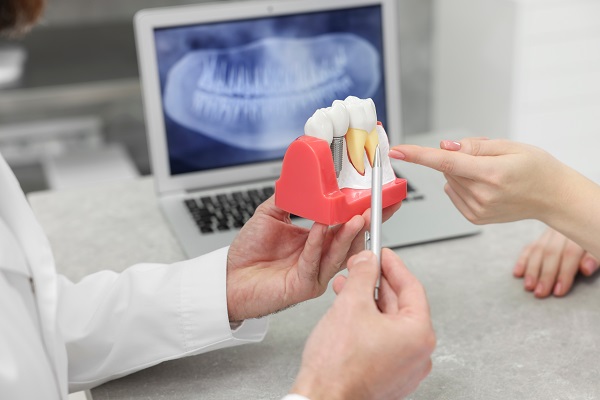What you should know before you get an extraction and why you should consider bone grafting.
“Doc, just pull the tooth. It’s all the way in the back, no one will even see it.”
Before you get an extraction, it is important to consider your options for replacing that tooth. Depending on how many teeth are extracted or how many teeth are already missing, your options can include partial dentures, bridges, or dental implants. Regardless of what option you choose, it is important that you replace your missing teeth in order to maintain proper function and prevent undesirable stress on your remaining teeth.
So what happens when you lose a tooth? If your dentist told you that you needed to have one of your front teeth extracted, you would most likely want to replace it as soon as possible. You wouldn't want to go to work or out on a date when you're missing your front tooth. You would probably be self-conscious smiling in public. But replacing back teeth after they are lost is just as important as replacing front teeth for several reasons. First of all, the back teeth maintain what is called vertical dimension of occlusion or VDO. VDO is the arbitrary distance between the upper and lower jaws when the teeth are closed all the way. When the teeth in the back are extracted, you can no longer maintain your proper VDO and the face begins to sink in. The teeth in the back are bigger and stronger than your front teeth because they receive a majority of the forces from everyday biting and chewing. When you lose your back teeth, those biting forces are transmitted to the front teeth. Your front teeth are not equipped to handle larger forces and, over time, they will begin to loosen and fracture.
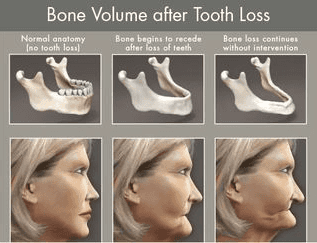
This figure shows a middle aged woman. Picture A shows how this woman would appear if she retained her natural teeth throughout her life. Picture B shows how this same woman would appear immediately after getting her teeth extracted. Picture C shows how she would look if her teeth had been extracted 10 years earlier. The woman appears much older in pictures B and C than she does in picture A, even though she is the same age in all 3 images. This illustration shows how losing teeth can significantly impact facial esthetics and aging. You will notice that her mouth seems to be “sinking in”, giving her a more concave profile. This is due to loss of vertical height in the lower 1/3rd of her face as well as insufficient lip and cheek support.
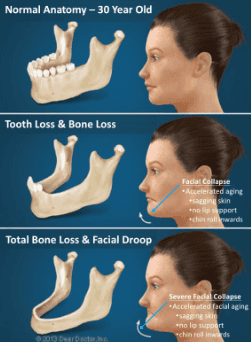
This figure shows another example of facial changes that are observed after losing teeth. Picture A shows a young woman with all of her teeth. Picture B shows how her cheeks begin to cave in after the back teeth are lost, and picture C shows how the lips begin to sink in after the front teeth are lost.
Alveolar bone is the bone that surrounds our teeth. It is thick and strong in order to provide a sturdy foundation to support our teeth. When a tooth is lost, the bone realizes that it is no longer needed to support anything in that area. It will start to resorb away, becoming shorter and thinner. Since the teeth and alveolar bone are no longer there to support the facial structures, you will start to see a sinking in of the lips or cheeks. There will be an even more dramatic change is facial support with continued tooth and bone loss. If there is continued tooth and bone loss, the facial changes will be even more apparent.
Losing teeth can have a significant impact on the way we look, even if we only lose teeth that are in the back of our mouth; we also know that it's very important to replace those teeth. The last thing we need to talk about is something that can help preserve the bone and gums at the extraction site. Bone grafting material is a powdered cadaver or bovine bone that is placed in the extraction site to prevent the remaining bone and gums from shrinking. Many dentists consider bone grafting to be the standard of care for extraction sites especially in the smile zone or in places where are dental implant is being considered. Bone grafting maintains the structure of the bones and gums after extraction. If you are considering a dental implant, you should know that the proper placement of the implant requires an adequate amount of bone. Crowns and bridges that are placed in areas where teeth were lost or extracted and no bone grafting was performed usually risk unsightly esthetic outcomes. For example, look at the patient in the figure below.
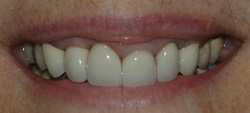
This patient had her right central incisor extracted without bone grafting. Notice how much longer the right central incisor looks compared to her left. The pontic, or the fake replacement for the missing tooth, had to be fabricated longer than the adjacent teeth to meet the new position of the gum line. Because the patient did not get a bone graft, the patient experienced both bony and soft tissue defects that naturally occur following any extraction. Extractions without the use of bone grafting will result in shrinkage of bone and gums, however these changes can be prevented by incorporating bone grafting material into the extraction sites.
In comparison, examine how bone grafting can positively affect extraction sites in the figure below. This patient had both of her lateral incisors extracted, but this time bone grafting was performed. When extraction sites are preserved the gums and bones do not shrink as much and the teeth look like they are a normal length.
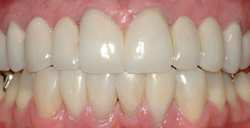
Take home messages: As always, be proactive about your dental treatments and never be afraid to ask your dentist questions. Talk to your dentist about your restorative options before you get an extraction and strongly consider bone grafting (especially in smile zone). Bone grafting is not an unnecessary procedure or another way for your dentist to make an extra buck, it is well worth the additional cost to ensure you have the best outcome and keep all of your restorative options open. A simple bone grafting procedure can be all the difference between having a cosmetically attractive smile and esthetic outcome.
References (Content and Pictures) with a special thank you to our colleagues.
1 http://www.dentaleconomics.com/articles/print/volume-102/issue-7/practice/is-socket-grafting-standard-of-care.html
2 http://www.burbankdentalimplants.com/why-even-have-missing-teeth-replaced-dental-implants-etc/
3. http://naturaldentistrycenter.com/natural/biocompatible-implants/
General Dentist > Long Grove Dental
Recent Posts
For patients who have been suffering from a damaged or infected tooth, finally getting the tooth extracted can feel like a relief. However, bleeding after a tooth extraction can be worrisome and inconvenient. Before a patient undergoes a tooth extraction, it can be helpful to know what to expect in terms of bleeding.After a tooth…
Tooth extraction can be frightening, but it is often necessary in order to keep a healthy mouth. There are a few important things to note about what comes after a tooth extraction, whether it be recovery or replacing the extracted tooth. In this article, we go over tooth extractions and what comes afterward. If you have…
When describing the exciting highlights of your day, a tooth extraction will probably not come close to the top of the list. Having a tooth extracted is never a pleasurable experience, but the procedure is essential because of its impact on your oral health and the appearance of your smile.If you have a tooth extraction…
Sometimes teeth extraction is the best solution for some conditions. The situation could be any of the following: Severe tooth damage Wisdom Teeth Issues Shifting or misaligned teeth Ankylosed teeth (milk teeth not falling out) Jaw Issues Underlying issues such as tumor or cystIf you have been booked for teeth extraction, knowing what to expect…




